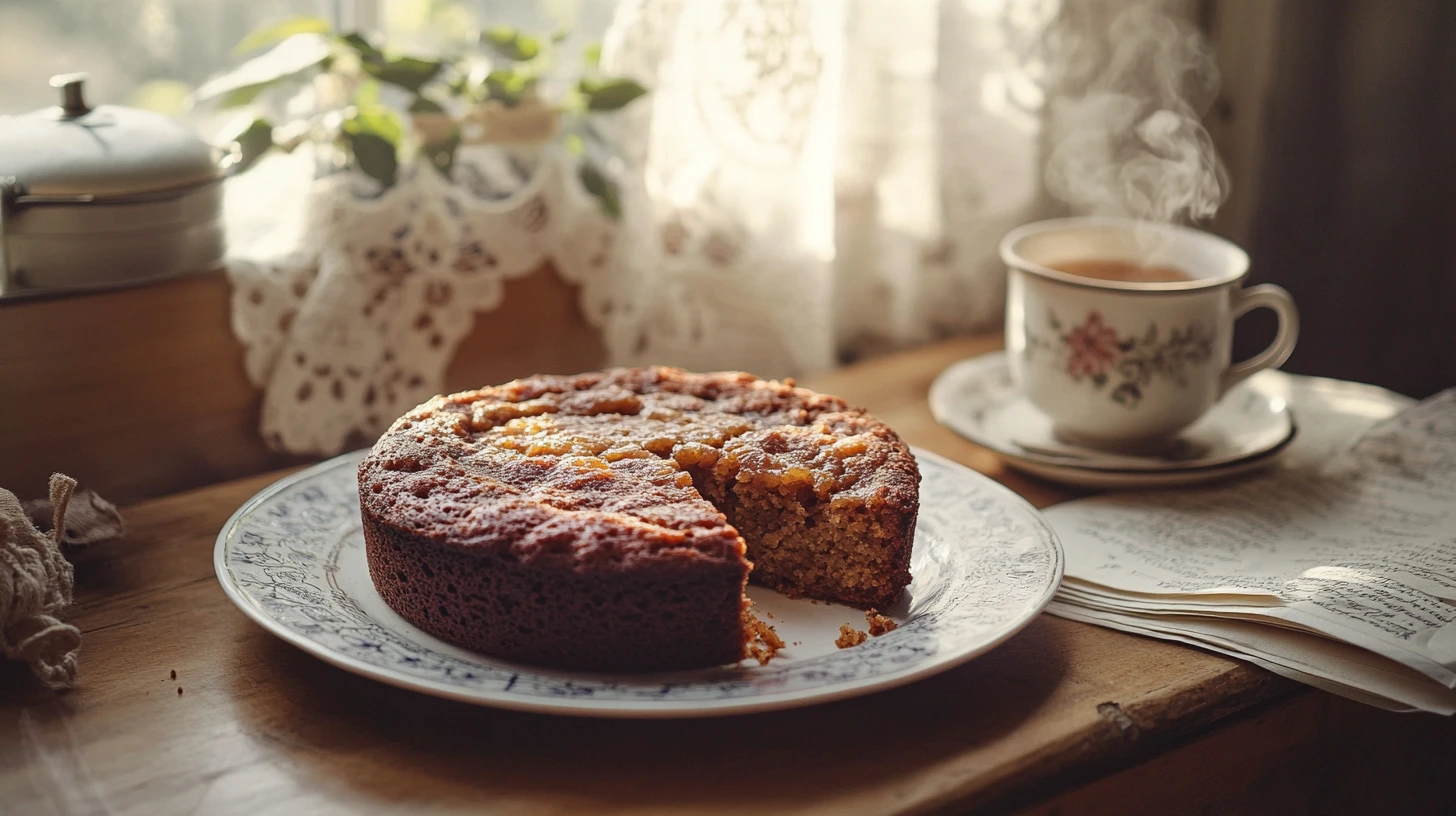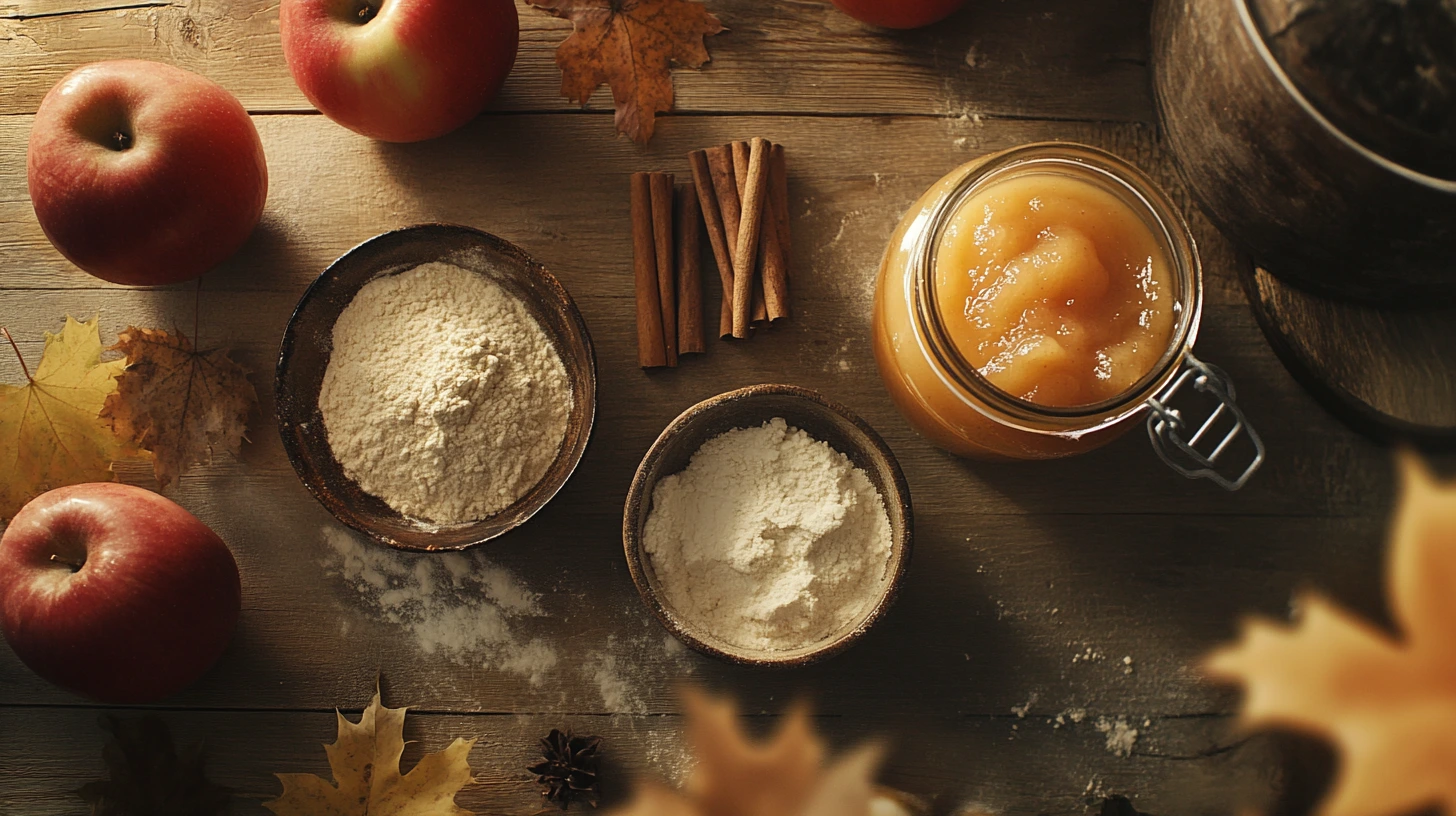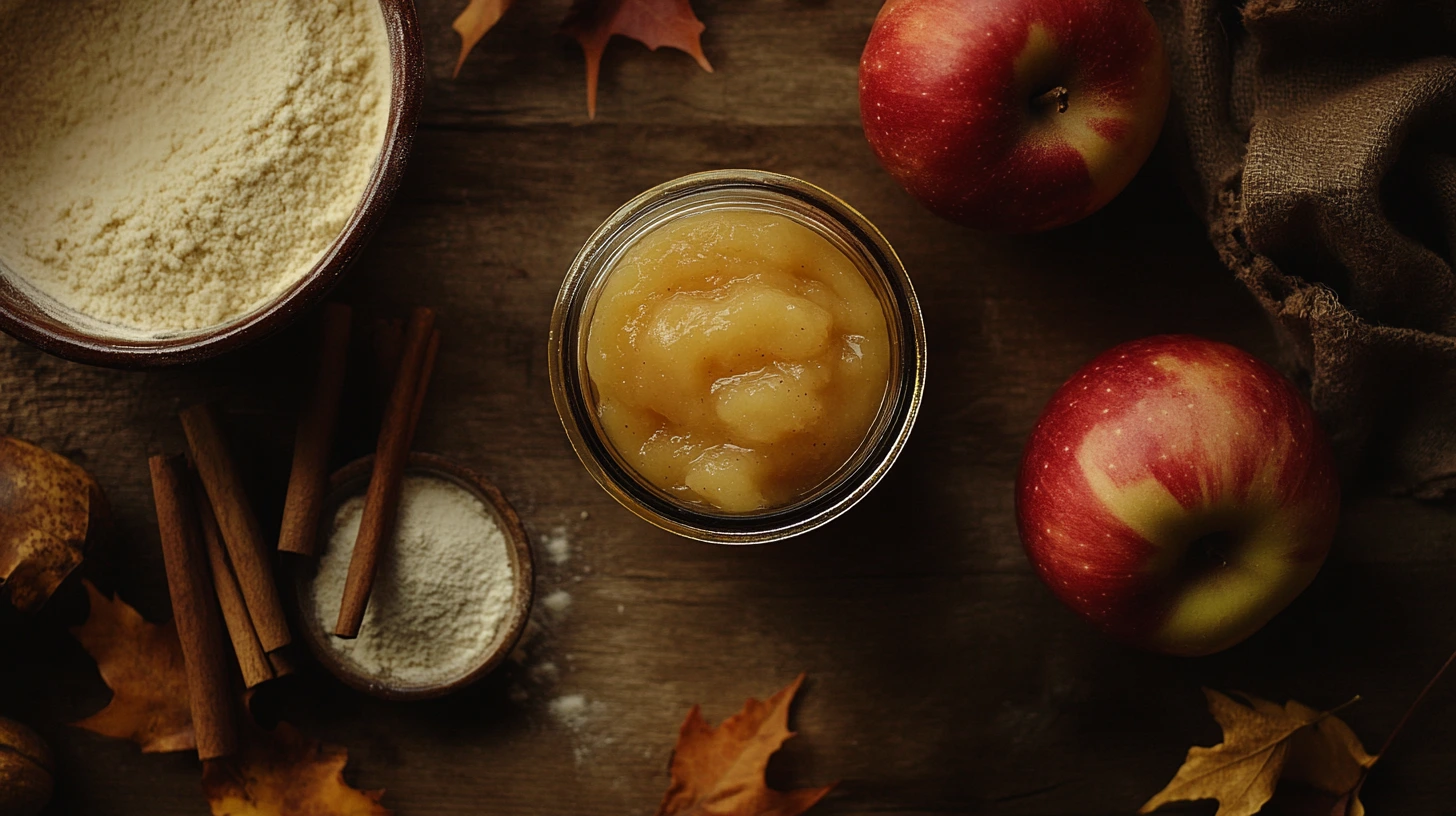
Table of Contents
Introduction to Applesauce Cake Recipe – What is Applesauce Cake?
The applesauce cake recipe is a delightful, traditional dessert that combines the natural sweetness of applesauce with warm, aromatic spices. It is loved for its moist texture, rich flavor, and comforting qualities. Often regarded as a classic “grandma’s recipe,” this cake is special in family gatherings and holiday celebrations.
Applesauce in the batter serves multiple purposes—it enhances the cake’s flavor, acts as a natural sweetener, and keeps it incredibly moist. Additionally, applesauce often replaces some or all of the fat in the recipe, making it a lighter and healthier dessert option.
Perfect for any occasion, applesauce cake can be customized with various add-ins like raisins, nuts, or a touch of glaze. Whether enjoyed as a breakfast treat, an afternoon snack, or a festive dessert, this cake is a timeless classic that appeals to all ages.
Ingredients Overview
Essential Ingredients for Applesauce Cake Recipe

Dry Ingredients:
- 2 cups all-purpose flour
- One teaspoon of baking soda
- One teaspoon of baking powder
- 1/2 teaspoon salt
- One teaspoon ground cinnamon
- 1/2 teaspoon ground nutmeg
- 1/4 teaspoon ground cloves
Wet Ingredients:
- 1 cup unsweetened applesauce
- 3/4 cup brown sugar (packed)
- 1/2 cup granulated sugar
- 1/2 cup vegetable oil (or melted butter)
- Two large eggs (or flaxseed eggs for a vegan option)
- One teaspoon of vanilla extract
Optional Add-ins:
- 1/2 cup chopped nuts (e.g., walnuts or pecans)
- 1/2 cup raisins or dried cranberries
- Powdered sugar or cream cheese frosting for topping (optional)
Instructions
Preheat the Oven:
Preheat your oven to 350°F (175°C). Grease and flour a 9-inch round or square cake pan, or line it with parchment paper.
Mix the Dry Ingredients:
Whisk together the flour, baking soda, baking powder, salt, cinnamon, nutmeg, and cloves in a medium bowl. Set aside.
Combine the Wet Ingredients:
Combine the applesauce, brown sugar, granulated sugar, oil, eggs, and vanilla extract in a large mixing bowl. Whisk until smooth.
Incorporate Dry Ingredients:
Gradually add the dry ingredients to the wet mixture, stirring gently with a spatula or whisk until combined. Stay undermixed.
Fold in Add-ins (Optional):
If using, fold in chopped nuts or raisins for added texture and flavor.
Pour into Pan:
Pour the batter evenly into the prepared cake pan and smooth the top with a spatula.
Bake:
Bake in the oven for 30–35 minutes or until a toothpick inserted into the center comes clean.
Cool:
Allow the cake to cool in the pan for 10 minutes, then transfer it to a wire rack to cool completely.
Serve:
Dust with powdered sugar or frost with cream cheese frosting if desired. Slice and serve!
Variations and Substitutions
Applesauce cake is wonderfully adaptable. Here are some variations and substitutions:
- Sweeteners: Swap sugar with honey, maple syrup, or coconut sugar for a different flavor profile.
- Flour: Use gluten-free flour blends or almond flour for a gluten-free option.
- Eggs: Replace eggs with flaxseed meal or chia seeds mixed with water for a vegan version.
- Oil: Use coconut, olive, or Greek yogurt instead of vegetable oil.
- Add-ins: Incorporate raisins, chopped nuts, shredded coconut, or chocolate chips for extra texture and flavor.
- Spices: Adjust the spice levels to your preference, or try cardamom and ginger for a unique twist.
Best Applesauce Types to Use
The type of applesauce you use can influence the cake’s taste and texture:
- Unsweetened Applesauce: Recommended for better control over the sweetness of the cake.
- Chunky Applesauce: Adds texture with tiny bits of apple.
- Homemade Applesauce: Offers fresh, natural flavor with no added preservatives.
- Flavored Applesauce: Cinnamon or spiced applesauce can amplify the cake’s warm spice notes.
- Store-Bought: A convenient option, but opt for brands with minimal added sugar or artificial ingredients.
Step-by-Step Applesauce Cake Recipe Preparation Guide

Preparing the Batter
- Gather Ingredients and Tools:
- Before starting, measure all your ingredients and preheat the oven to 350°F (175°C). Grease and line your cake pan with parchment paper to ensure easy removal.
- Prepare the Dry Ingredients:
- Whisk together all-purpose flour, baking soda, baking powder, salt, cinnamon, nutmeg, and cloves in a medium-sized bowl. This helps evenly distribute the leavening agents and spices, ensuring consistent flavor and texture.
- Mix the Wet Ingredients:
- Whisk together applesauce, brown sugar, granulated sugar, oil (or melted butter), eggs (or flax eggs for a vegan option), and vanilla extract in a large mixing bowl. Make sure the mixture is smooth and well-combined.
Mixing Techniques for Fluffy Results
- Incorporate Dry into Wet Gradually:
- Add the dry ingredients to the wet mixture in 2–3 batches. Use a spatula or a wooden spoon to fold the mixture gently. This method prevents overmixing, which can lead to a dense cake.
- Folding Add-ins:
- If using raisins, nuts, or other add-ins, gently fold them after thoroughly mixing the batter. This ensures even distribution without overworking the batter.
- Avoid Overmixing:
- Mix only until the flour is just incorporated. Overmixing activates the gluten in the flour, making the cake tough instead of tender.
Adjusting the Sweetness and Spice Levels
- Sweetness Adjustments:
- Reduce the granulated sugar or use unsweetened applesauce for a less sweet cake.
- For a sweeter version, Add an extra tablespoon of sugar or drizzle honey or maple syrup into the batter.
- Spice Customization:
- Bolder spice flavor: Increase the cinnamon to 1 1/2 teaspoons or add a pinch of cardamom or ginger.
- Milder spice flavor: Reduce the amount of nutmeg and cloves slightly.
- Taste Test:
- After mixing the wet ingredients, taste the batter (if no raw eggs are used) to adjust sweetness or spice before combining with the dry ingredients.
Storing and Freezing Tips
How to Store Leftovers Properly
- Room Temperature Storage:
- If the cake is unfrosted, it can be stored at room temperature in an airtight container for 2–3 days.
- Ensure the cake has cooled completely before sealing it to avoid condensation and sogginess.
- Refrigeration:
- For frosted or cream cheese-topped cakes, store them in the refrigerator. To maintain freshness, place the cake in an airtight container or wrap it tightly with plastic wrap.
- It will stay fresh for up to 5–7 days when refrigerated.
Best Practices for Freezing
- Freezing Unfrosted Cake:
- Wrap individual slices or the entire cake tightly in plastic wrap. Wrap again with aluminum foil or place in a freezer-safe bag for extra protection.
- Label the package with the date to keep track. The cake can be frozen for up to 3 months.
- Freezing Frosted Cake:
- Flash-freeze the cake on a tray for 1–2 hours to harden the frosting, then wrap it tightly with plastic and aluminum foil.
- Be gentle when wrapping to avoid damaging the frosting.
- Thawing Instructions:
- Thaw unfrosted cake at room temperature for a few hours or overnight in the refrigerator.
- Thaw in the refrigerator for frosted cakes to keep the frosting intact and prevent condensation.
Reheating Instructions
- Microwave:
- For individual slices, microwave on medium power for 10–15 seconds to warm slightly. Be cautious not to overheat, especially with frosted cakes.
- Oven:
- Preheat the oven to 300°F (150°C). Wrap the cake slice or whole cake in aluminum foil to prevent drying. Warm for 10–15 minutes, depending on size.
- Serve at Room Temperature:
- Applesauce cake tastes best at room temperature, so let it sit out for 10–15 minutes after reheating to achieve the ideal texture and flavor.
Nutritional Information
Calories per Serving
The caloric content of applesauce cake can vary depending on the ingredients and portion size. Here’s an estimate for a standard recipe:
- Calories per Serving: Approximately 250–300 calories per slice (based on 12 slices in a 9-inch cake).
- This calculation assumes standard ingredients like sugar, vegetable oil, and all-purpose flour. Add-ins like nuts or frosting will increase the calorie count.
Nutritional Benefits of Applesauce Cake Recipe
- Lower Fat Content:
- Applesauce often replaces some or all of the oil or butter in recipes, making the cake lower in fat than traditional cakes.
- Natural Sweetness:
- Unsweetened applesauce contributes natural sugars, which can reduce the need for additional sweeteners.
- Rich in Spices:
- Spices like cinnamon, nutmeg, and cloves enhance flavor and provide antioxidants and anti-inflammatory benefits.
- Versatile Nutrition:
- Whole wheat flour can boost the fiber content.
- Adding nuts or dried fruits increases protein, healthy fats, and micronutrients like potassium and iron.
Tips for Reducing Calories
- Reduce Sugar:
- You can use a mix of applesauce and a natural sweetener like stevia, or you can cut the sugar by up to 25% without significantly affecting the flavor.
- Swap Flour:
- Use half all-purpose flour and half whole wheat or almond flour for added fiber and protein with fewer refined carbs.
- Replace Oil:
- Substitute vegetable oil with more applesauce, Greek yogurt, or mashed bananas. This can significantly lower the fat content while maintaining moisture.
- Portion Control:
- Cut smaller slices to manage calorie intake without sacrificing enjoyment.
- Frosting Alternatives:
- Skip heavy cream cheese frosting and opt for a light dusting of powdered sugar or a drizzle of glaze made with lemon juice and powdered sugar.
FAQs About Applesauce Cake Recipe
Why Use Applesauce in Cakes?
- Natural Sweetener: Applesauce adds a mild, natural sweetness to the cake, reducing the need for additional sugar.
- Moisture and Tenderness: It locks in moisture, resulting in a soft and tender crumb.
- Healthier Option: Applesauce is a low-fat alternative to butter or oil, reducing the cake’s overall calorie content.
- Flavor Enhancer: It imparts a subtle apple flavor that complements spices like cinnamon and nutmeg, enhancing the cake’s overall taste.
Can I Use Homemade Applesauce?
Yes, homemade applesauce is an excellent option for applesauce cake. Here’s why:
- Customizable Flavor: Homemade applesauce can be tailored with spices like cinnamon or nutmeg to suit the cake’s flavor profile.
- Healthier Choice: By making it yourself, you can control the amount of sugar and avoid preservatives.
- Consistency Control: You can choose a chunky or smooth texture based on your preference.
Tip: Ensure your homemade applesauce has a similar consistency to store-bought versions. Adjust by adding water if it is too thick or reducing it on the stove if it is too watery.
How Do I Prevent Dryness?
- Accurate Measurements: Use precise measurements for wet and dry ingredients to maintain a proper balance.
- Avoid Overmixing: Overmixing can activate the gluten in flour, leading to a dense and dry cake. Mix until the ingredients are just combined.
- Monitor Baking Time: Overbaking dries out cakes. Check for doneness a few minutes before the suggested baking time using a toothpick.
- Use Enough Applesauce: Ensure the applesauce is not reduced below the recipe’s requirement, as it’s a key ingredient for moisture.
- Store Properly: Cool the cake completely before storing it in an airtight container to retain moisture.
What Does Applesauce Replace in Cake Mix?
- Oil or Butter:
- Applesauce is most commonly used to replace oil or butter, making the cake healthier while maintaining moisture.
- Replacement Ratio: Use a 1:1 ratio (e.g., 1/2 cup applesauce for 1/2 cup oil or butter).
- Eggs:
- Applesauce can substitute eggs, especially in vegan baking, by providing moisture and binding.
- Replacement Ratio: Use 1/4 cup applesauce per egg. Add 1/2 teaspoon baking powder for better structure if needed.
- Sugar (Partially):
- Unsweetened applesauce adds natural sweetness, allowing for a reduction in added sugar.
- Adjustment Tip: Reduce sugar by about 1/4 cup for every cup of applesauce used.
Troubleshooting Common Issues
Why Didn’t My Cake Rise?
- Expired Leavening Agents:
- Baking soda or baking powder may be expired or inactive. Always check the expiration date and test their effectiveness before using.
- Test Tip: Mix baking powder with hot water or baking soda with vinegar; if it fizzes, it’s still active.
- Incorrect Measurements:
- Using less flour or more leavening agents can help the rise. Use measuring cups or a kitchen scale to ensure accurate measurements.
- Overmixing the Batter:
- Overmixing develops gluten, which can lead to a dense cake. Mix just until the ingredients are combined.
- Baking Temperature Issues:
- The cake won’t rise properly if the oven temperature is too low. Use an oven thermometer to ensure the correct temperature.
- Moisture Imbalance:
- Too much liquid or applesauce can make the batter too heavy to rise. Therefore, it is essential to follow the recipe’s ingredient ratios carefully.
How to Fix Uneven Textures
- Dense or Gummy Cake:
- Cause: Overmixing, excessive applesauce, or underbaking.
- Solution: Next time, measure ingredients accurately, mix gently, and check for doneness with a toothpick before removing from the oven.
- Dry Cake:
- Cause: Overbaking, not enough applesauce, or insufficient liquid.
- Solution: To restore moisture, add a light glaze, syrup, or frosting. In future attempts, adjust baking time or ingredient ratios.
- Crumbly Cake:
- Cause: Too much flour or not enough eggs/applesauce.
- Solution: Use proper ingredient measurements to balance wet and dry components.
Solving Flavor Imbalances
- Too Sweet:
- Cause: Excess sugar or overly sweet applesauce.
- Solution: Balance with a tangy frosting (e.g., cream cheese) or reduce sugar in future attempts.
- Bland Flavor:
- Cause: Insufficient spices or vanilla extract.
- Solution: Add more cinnamon, nutmeg, or a pinch of salt to enhance the overall flavor.
- Overpowering Spices:
- Cause: Using too much cinnamon, nutmeg, or cloves.
- Solution: Pair with a neutral topping like whipped cream to mellow the spices. Adjust spice levels in future bakes.
Conclusion and Final Thoughts
Applesauce cake is more than just a dessert—it celebrates simplicity, flavor, and comfort. With its moist texture, warm spices, and natural sweetness, this classic treat is perfect for any occasion, from family gatherings to casual afternoon snacks.
Applesauce cake is endlessly versatile, whether you’re exploring healthier baking alternatives, experimenting with add-ins like nuts or raisins, or making adjustments for dietary needs. Following proper techniques and troubleshooting common issues ensures your cake is always a delightful success.
The beauty of applesauce cake lies in its ability to bring people together, evoking feelings of warmth and nostalgia. So, whether served plain, frosted, or dusted with powdered sugar, every bite will create lasting memories.
Happy baking, and enjoy the sweet, spiced goodness of applesauce cake!
Try this recipe tonight and tag us @biscsweet on social media and follow us on Facebook.
